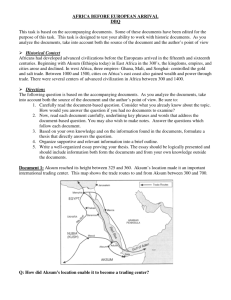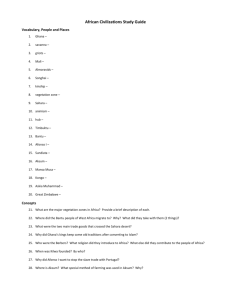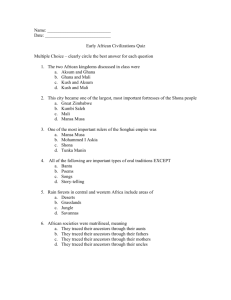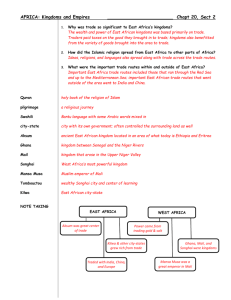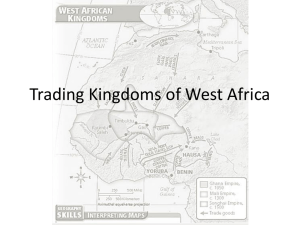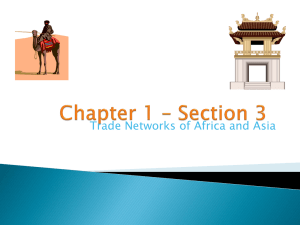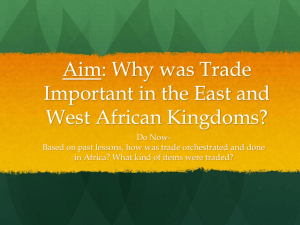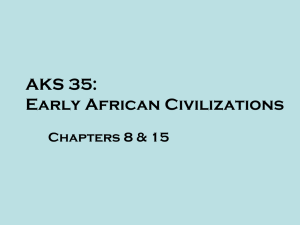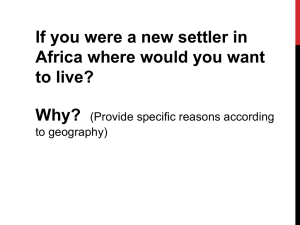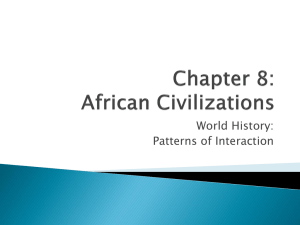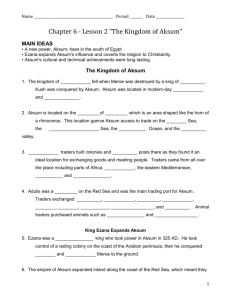Africa History Reading/Cornell Notes
advertisement
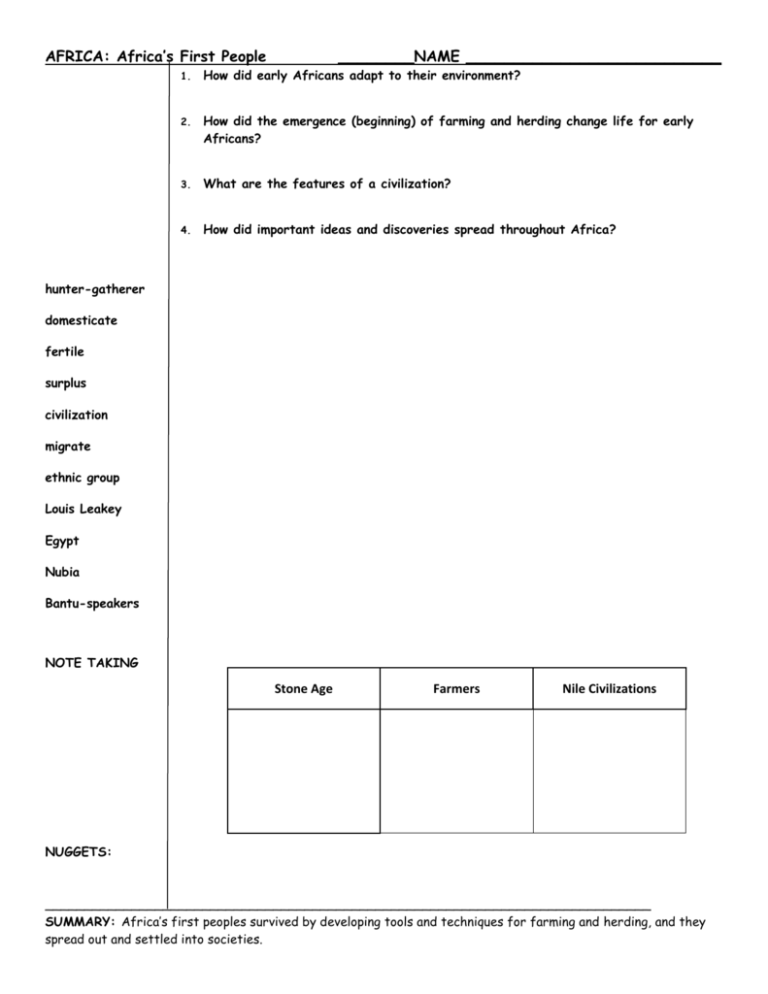
AFRICA: Africa’s First People ________NAME ___________________________ 1. How did early Africans adapt to their environment? 2. How did the emergence (beginning) of farming and herding change life for early Africans? 3. What are the features of a civilization? 4. How did important ideas and discoveries spread throughout Africa? hunter-gatherer domesticate fertile surplus civilization migrate ethnic group Louis Leakey Egypt Nubia Bantu-speakers NOTE TAKING Stone Age Farmers Nile Civilizations NUGGETS: _____________________________________________________________________________ SUMMARY: Africa’s first peoples survived by developing tools and techniques for farming and herding, and they spread out and settled into societies. Today the dry sands of the Sahara Desert cover most of North Africa. Until about 4,000 years ago, however, this large area held enough water to support many people and animals. Scientists think that Africa’s first farmers lived there. Paintings on cliffs and walls tell their story. Q: This painting was originally found in Algeria. What do you think the horns on this woman’s helmet suggest? Why? But the continent’s first people lived in East Africa. We know this because of the stones and bones they left behind. HUNTER-GATHERERS The earliest humans probably survived by gathering wild fruits, nuts, and roots. These hunter-gatherers also hunted animals for meat and clothing. They made tools out of wood, animal bones, and then stone. The first use of stone tools marks the beginning of a period scientists call the Stone Age. These same tools worked very well. The scientist Louis Leakey found some of the first evidence of early people in East Africa. He also taught himself to make and use the tools he had discovered. FARMING AND HERDING When hunter-gatherers began to farm and to herd animals, they probably planted wild grains such as wheat, barley, sorghum, and millet. At first, gatherers just protected the areas where these grains grew best. Later they began to save some seed to plant for the next year’s crop. Later people began to domesticate plants, or adapt them for their own use. People also domesticated animals by taming them and developing ways to use them. Domesticating plants and animals meant people could plant their own crops. They did not have to travel to places where grains where already growing. As a result, they could settle in a certain place, usually where the land was fertile, or productive. Some communities produced a food surplus, or more than they needed. Surpluses allowed some people in the community to do work other than farming. Q: How did the emergence (beginning) or farming and herding change life for early Africans? EARLY FARMING When hunter-gatherers settle down in one area and became farmers, they spent many hours tilling, planting by hand, harvesting crops, and caring for domesticated animals. They used only tools that they could make by hand. Farmers used axes, like this one, to clear the land. Q: Why would food surpluses allow some people in a community to do work other than farming? Q: Would it be more difficult to be a hunter-gatherer or a farmer? Why? THE THIRST ZONE Africa’s first farmers probably lived in Algeria, in North Africa. Thousands of years ago, more rain fell in this region. But today, much of North Africa is known as “The Thirst Zone.” People need to drink about 2.5 quarts of water per day. People also use water for washing and farming. All total, each person needs at least 21 quarts of water per day. In the Thirst Zone, only about five (5) quarts of water per person is available. Q: What adjustments to their life style would people have to make if they only got ¼ of the total water they needed? CIVILIZATIONS ON THE NILE A civilization is a society with cities, a government, and social classes. Social classes form when people do a variety of jobs. Civilizations also have architecture, writing, and art. One civilization arose on the Nile River about 5,000 years ago. Q: What are the features of a civilization? TWO ANCIENT AFRICAN CIVILIZATIONS EGYPT: Each summer the Nile River flooded its banks. It left a layer of fertile silt that was ideal for farming. People began farming along the banks of the Nile by around 4000 B.C. They settled in scattered villages. Over the centuries, these villages grew into the civilization of ancient Egypt. Ancient Egypt was ruled by kings and queens called pharaohs. The people believed the pharaohs were gods as well as kings. When some pharaohs died, they were buried in pyramids. People painted murals and picture-writing, called hieroglyphics, on the walls in these pyramids. Egyptian civilization included more than just the pyramids. The Egyptians were advanced in paper-making, architecture, medicine, and mathematics. NUBIA: Starting in about 6000 BC, several civilizations arose south of Egypt. This area was called Nubia. The final and greatest Nubian kingdom arose in the city of Meroe (“MER-oh-ee”) during the 500s BC. It thrived until about the middle of the A.D. 300s. Meroe was probably the first place in Africa where iron was made. Q: What made each of these early African civilizations important? THE BANTU MIGRATIONS By about 500 B.C., West Africans had learned to heat and shape iron. They used it to form parts of tools, such as arrowheads, ax heels, and hoe blades. The strong tools made farming easier and created food surpluses. The strong iron made farming easier and created food surpluses. As a result, West Africa’s population increased. Around 2000 years ago, a group of people who spoke Bantu (“BAN-too”) languages began to migrate, or move, out of West Africa, perhaps looking for new land to farm. Over hundreds of years, these Bantu-speakers settled in Central and Southern Africa. They introduced farming, herding, and iron tools to these regions. Today, people in this part of Africa belong to hundreds of ethnic groups, or groups that share languages, religions, family ties, and customs. But almost all of these ethnic groups speak Bantu languages. Q: How did important ideas and discoveries spread throughout Africa? AFRICA: Kingdoms and Empires ____________NAME _______________________ 5. Why was trade so significant to East Africa’s kingdoms? 6. How did the Islamic religion spread from East Africa to other parts of Africa? 7. What were the important trade routes within and outside of East Africa? Quran pilgrimage Swahili city-state Aksum Ghana Mail Songhai Mansa Musa NOTE TAKING EAST AFRICA WEST AFRICA NUGGETS _____________________________________________________________________________ SUMMARY: African societies were influenced by traders from other cultures who brought not only goods, but also new religions and languages. Adulis was the most important city in Aksum, a bustling trade center along the Red Sea. In the year A.D. 1, a Greek writer make a list of things you buy there: Cloth make in Egypt…and brass, which is use for ornaments and cut pieces instead of coin; sheets of soft copper, used for cooking utensils and cut up for bracelets and anklets for the women; iron, which is make into spears… AN EAST AFRICAN KINGDOM Aksum was located in East Africa, in what is now Ethiopia and Eritrea. Around 1000 B.C. African and Arab traders began settle along the west coast of the Red Sea. These were the ancestors of the people of Aksum. Over time, Aksum came to control trade in the Red Sea. In time, Aksum would control a trade network that stretched from the Mediterranean Sea to India. Ideas, as well as good, traveled along these trade routes. The Christian religion traveled to Aksum along these routes. In fact, Aksum became a center of the early Ethiopian Christian Church. But Aksum began to decline in the A.D. 600s. Then, Arabs took control of much of the region’s trade. WEST AFRICAN KINGDOM As Aksum declined great kingdoms arose on the other side of the continent, in West Africa. The power of these kingdoms was based on the trade of salt and gold, People needed salt to survive, especially in hot areas like West Africa, but the people had to local sources of salt. However, they had plenty of gold. For the people of North Africa, the opposite was true: they had salt, but no gold. A brisk trade between North Africa and West Africa quickly grew. Control of this trade brought power and riches to three West Africa kingdoms – Ghana, Mali, and Songhai. GHANA: The Kingdom of Ghana was located between the Senegal and Niger rivers. From this location, Ghana controlled trade across West Africa. Ghana’s kings grew rich from the taxes they charged on the salt, gold, and other goods that flowed through their land. The flow of gold was so great that Arab writers call Ghana “land of gold.” But in time, Ghana lost control of the trade routes. It gave way to a new power, the Kingdom of Mali. MALI. The Kingdom of Mali arose in the mid-1200s in the upper Niger River Valley. Mali’s powerful kings controlled both the gold mines of the south and the salt supplies of the north. In Mali, the king was called Mansa, which mean emperor. Mali’s most famous king, Mansa Musa, brought peace and order to the kingdom during his 25-year reign. He based his laws on the Quran, the holy book of Islam. Over the centuries, Muslim traders had spread their religion into many parts of Africa. In 1324, Mansa Musa made a pilgrimage – a religion journey – the Arabian city of Mecca, a Muslim holy place where Muhammad, the prophet who first preached Islam, was born. Mansa Musa brought 60,000 people and 80 camels with him, Each camel carried 300 ponds of gold Mansa Musa gave to people along the way. Mansa Musa’s pilgrimage brought about new trading ties with other Muslim state. It also displayed Mali’s wealth. Hearing the reports, Europe’s rulers grew interested in African gold. SONGHAI. In time, Songhai became West Africa’s most powerful kingdom, replacing Mali. Its rulers controlled important trade routes and wealthy trading cities, such as Tombouctou, also a great Muslim learning Center. Songhai people still live near t=he Niger River, and Islam remains important in the region. EAST AFRICAN CITY STATES As in West Africa, trade helped East African cities to develop. Around the time that Aksum declined, trading cities arose along East Africa’s coast. Traders from these cities carted animal skins, ivory, and gold and other metals to India and China. The traders brought back many different goods. Some of the traders who visited the area where Muslims. In time, a new language called Swahili developed in the area. It was a Bantu language with some Arab words mixed in. Today, many East Africans speak Swahili. Some East Africa cities grew into powerful city-states. A city-state has its own government and controls much of the surrounding land. Among the greatest of these city-states were Malindi, Mombassa, and Kilwa. These city-state grew rich from trade and huge taxes traders paid on goods they brought into the city. KILWA. Ibn Batuta, a Muslim traveler from North Africa, visited Kilwa in 1331. He had seen great cities in China, India, and West Africa, but he wrote that Kilwa was “one of the most beautiful and best-constructed towns in the world.” There people lived in three-and four-story houses made of stone and sea coral.
